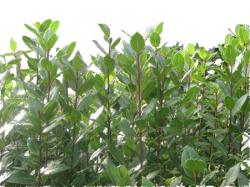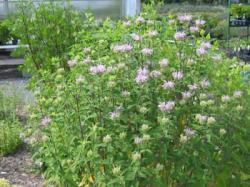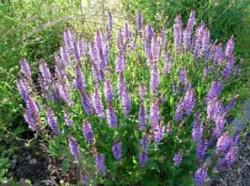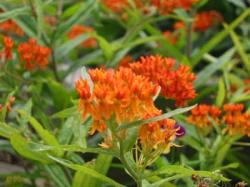Your search for Herbs begining with the letter B returned 43 items.
A | B | C | D | E | F | G | H | I | J | K | L | M | N | O | P | Q | R | S | T | U | V | W | X | Y | Z
Displaying items 31 thru 43
Basil.
Ocimum basilicum 'Thai Siam Queen'. This is a knockout as an ornamental and its leaves have an assertive anise scent, perfect for Asian food. Siam Queen's standout feature is its radiant purple, ball-headed inflorescences, containing many individual stems with lavender or pink blossoms. Green leaves are 3 1/2 inches long by 1 1/4-inch wide. Plants are about 24 inches high. Space 15 to 20 inches apart. 1997 All American Selection winner.Last Seed Source: www.hpsseed.com
Basil.
Ocimum basilicum 'Valentino'. This large lettuce-leaf type basil reaches up to 2 feet tall.Last Seed Source: www.parkseed.com
Bay Laurel.
Laurus nobilis. Sweet Bay or Bay Laurel. This is the bay of commerce and the one seen growing in Europe. For our climate, it is usually a potted plant to be brought indoors, but in a fortuitous site, it may be grown outdoors with protection. Fresh leaves are used with meats and vegetables. Once you have a bay of your own, you will find many excuses to use it. Slow growing until well established.Bee Balm.
Monarda xmedia 'Petite Delight'. Perennial. Hardy to -30°F. A dwarf monarda with a height of 12-15 inches tall. Deep green foliage has lavender-pink flowers. Plant has moderate mildew resistance.Bee Balm.
Monarda xmedia 'Jacob Kline'. Perennial, hardy to - 25°F. Bright red flowers on a plant reputed to have some mildew resistance. Like all Monarda species, growth habit can be invasive.Bee Balm.
Monarda 'Raspberry Wine'. Perennial, hardy to - 30°F. Long Blooming variety. Flowers are a rich raspberry color. Height to 30 inches. Like all monarda, growth habit can be invasive.Bee Balm.
Monarda xmedia 'Marshall's Delight'. Perennial, hardy to -25°F. A product of an extensive breeding program in Canada, this cultivar is said to have the most resistance to powdery mildew. Most species, with the exception of M. fistulosa, have increased susceptibility to the ubiquitous fungus when their roots are allowed to dry out. Bright pink, edible flowers. Plants reach about 28 inches tall.Bergamot, Lemon/ Lemon Mint.
Monarda citriodora. Annual/Short-lived perennial often sold as Lemon Mint. This Monarda has strongly lemon-scented foliage which lend a delightful accent to tea. Leaves can also be used to flavor meat dishes and, along with the, beautiful, large lavender-pink flowers, eaten in salads. Grows to about 2 feet.Last Seed Source: www.seedsavers.org
Bergamot, Wild/ Bee Balm.
Monarda fistulosa. This hardy perennial produces bright lavender flowers and has highly fragrant leaves. Most bee balm (Monarda didyma) in cultivation today is actually of hybrid origin and has wild bergamot as one of its parents. Unlike its more commonly grown relatives, wild bergamot prefers dry soil conditions. Typically grown in full sun, this plant will tolerate some shade. Height is usually 3-4 feet tall and is moderately invasive. Both flowers and leaves are edible. Leaves are very spicy making them an excellent substitute for Oregano.Betony/ Wood Betony.
Stachys officinalis. Betony was an official herb of the apothecary, believed to have magical healing powers. It was grown in monastery gardens all over Europe. Today, its popularity has been surpassed by its close relative, lamb's ear, Stachys byzantina. Betony still deserves a place in the modern herb garden. It is a marvelous ornamental plant well suited for the cottage garden or the middle of the border with its reddish-purple flowers forming whorls along tall spikes which rise 2 to 3 feet above strongly aromatic basal foliage. Good for cut flowers.Last Seed Source: www.ivygarth.com
Borage.
Borago officinalis. Annual, hardy to 25°F. While you can make fritters from its flowers and use its cucumber-flavored, hirsute leaves in cold drinks like Pimm's Cup, borage acts as a magnet in the garden for pollinating bees. The blue flowers are also candied for cake decorating and used dried in wreaths. Height to 2 feet.Last Seed Source: www.johnnyseeds.com
Burnet.
Sanguisorba minor. A Frenchman would not be without ready access to burnet, the handsome ornamental with accordion green leaves. Its cucumber flavor is subtle, but unmistakable. Try it in vinegar, salad dressing, or just cut up in a salad. Height to 30 inches in flower. Space 18 to 24 inches apart. Perennial, hardy to -40°F. Lovely in the garden.Last Seed Source: www.johnnyseeds.com




